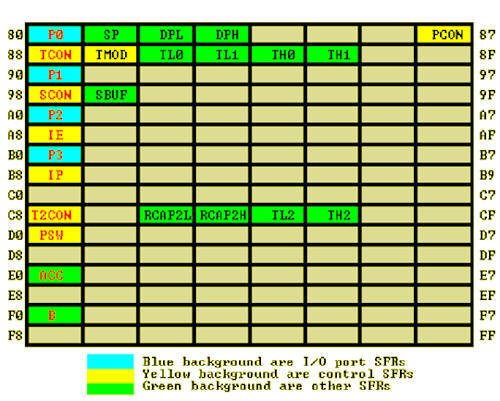8052
Microcontroller Tutorial
Additional Features in 8052
Author: Craig Steiner
Book:
The
8051/8052
Microcontroller:
Architecture,
Assembly
Language,
And
Hardware
Interfacing
(Paperback)
INTRODUCTION TO THE 8052
The 8052 microcontroller is the 8051's "big brother." It is a slightly more powerful microcontroller, sporting a number of additional features which the developer may make use of:
- 256 bytes of Internal RAM (compared to 128 in the standard 8051).
- A third 16-bit timer, capable of a number of new operation modes and 16-bit reloads.
- Additional SFRs to support the functionality offered by the third timer.
That's really about all there is to the difference between the 8051 and 8052. The remainder of this tutorial will explain these additional features offered by the 8052, and how they are used within user programs. Throughout this tutorial, it is assumed that you already have read the 8051 Tutorial and have a thorough understanding of it.
256 BYTES OF INTERNAL RAM
The standard 8051 microcontroller contains 128 bytes of Internal RAM that are available to the developer as working memory for variables and/or for the operating stack. Instructions that refer to addresses in the range of 00h through 7Fh refer to the 8051's Internal RAM, while addresses in the range of 80h through FFh refer to Special Function Registers (SFRs).
Although the 8052 has 256 bytes of Internal RAM, the above method of referencing them remains true. Any address between 00h and 7Fh refers to Internal RAM whereas address in the range of 80h through FFh refer to SFRs.
The 8052's additional Internal RAM may only be referred by Indirect Addressing. Indirect addressing always refers to Internal RAM, never to an SFR.
Thus, to read the value contained in Internal RAM address 90h, the developer would need to code something along the lines of the following:
MOV R0,#90h ;Set the indirect address to 90h
MOV A,@R0 ;Read the contents of Internal RAM pointed to by R0
The above code first assigns the value 90h to the register R0. It subsequently reads, indirectly, the contents of the address contained in R0 (90h). Thus, after these two instructions have executed, the Accumulator will contain the value of Internal RAM address 90h.
It is very important to understand that the above code is not the same as the following:
MOV A,90h ;Reads the contents of SFR 90h (P1)
This instruction uses direct addressing; recall that direct addressing reads Internal RAM when the address is in the range of 00h through 7Fh, and reads an SFR when the address is in the range of 80h through FFh. Thus in the case of this second example, the move instruction reads the value of SFR 90h-which happens to be P1 (I/O Port 1).
NEW SFRs FOR 8052'S THIRD TIMER
In addition to the 8051's standard 21 SFRs, the 8052 adds an additional 5 SFRs related to the 8052's third timer. All of the original 8051 SFRs function exactly as they do in the 8051-the 8052 simply adds new SFRs, it doesn't change the definition of the standard SFRs.
The five new SFRs are in the range of C8h to CDh (SFR C9h is not defined).

T2CON SFR
The operation of Timer 2 (T2) is controlled almost entirely by the T2CON SFR, at address C8h. Note that since this SFR is evenly divisible by 8 that it is bit-addressable.
| BIT | NAME |
BIT ADDRESS |
DESCRIPTION |
| 7 | TF2 | CFh | Timer 2 Overflow. This bit is set when T2 overflows. When T2 interrupt is enabled, this bit will cause the interrupt to be triggered. This bit will not be set if either TCLK or RCLK bits are set. |
| 6 | EXF2 | CEh | Timer 2 External Flag. Set by a reload or capture caused by a 1-0 transition on T2EX (P1.1), but only when EXEN2 is set. When T2 interrupt is enabled, this bit will cause the interrupt to be triggered. |
| 5 | RCLK | CDh | Timer 2 Receive Clock. When this bit is set, Timer 2 will be used to determine the serial port receive baud rate. When clear, Timer 1 will be used. |
| 4 | TCLK | CCh | Timer 2 Receive Clock. When this bit is set, Timer 2 will be used to determine the serial port transmit baud rate. When clear, Timer 1 will be used. |
| 3 | EXEN2 | CBh | Timer 2 External Enable. When set, a 1-0 transition on T2EX (P1.1) will cause a capture or reload to occur. |
| 2 | TR2 | CAh | Timer 2 Run. When set, timer 2 will be turned on. Otherwise, it is turned off. |
| 1 | C/T2 | C9h | Timer 2 Counter/Interval Timer. If clear, Timer 2 is an interval counter. If set, Timer 2 is incremented by 1-0 transition on T2 (P1.0). |
| 0 | CP/RL2 | C8h | Timer 2 Capture/Reload. If clear, auto reload occurs on timer 2 overflow, or T2EX 1-0 transition if EXEN2 is set. If set, a capture will occur on a 1-0 transition of T2EX if EXEN2 is set. |
TIMER 2 AS A BAUD-RATE GENERATOR
Timer 2 may be used as a baud rate generator. This is accomplished by setting either RCLK (T2CON.5) or TCLK (T2CON.4).
With the standard 8051, Timer 1 is the only timer which may be used to determine the baud rate of the serial port. Additionally, the receive and transmit baud rate must be the same.
With the 8052, however, the user may configure the serial port to receive at one baud rate and transmit with another. For example, if RCLK is set and TCLK is cleared, serial data will be received at the baud rate determined by Timer 2 whereas the baud rate of transmitted data will be determined by Timer 1.
Determining the auto-reload values for a specific baud rate is discussed in Serial Port Operation; the only difference is that in the case of Timer 2, the auto-reload value is placed in RCAP2H and RCAP2L, and the value is a 16-bit value rather than an 8-bit value.
NOTE: When Timer 2 is used as a baud rate generator (either TCLK or RCLK are set), the Timer 2 Overflow Flag (TF2) will not be set.
TIMER 2 IN AUTO-RELOAD MODE
The first mode in which Timer 2 may be used is Auto-Reload. The auto-reload mode functions just like Timer 0 and Timer 1 in auto-reload mode, except that the Timer 2 auto-reload mode performs a full 16-bit reload (recall that Timer 0 and Timer 1 only have 8-bit reload values). When a reload occurs, the value of TH2 will be reloaded with the value contained in RCAP2H and the value of TL2 will be reloaded with the value contained in RCAP2L.
To operate Timer 2 in auto-reload mode, the CP/RL2 bit (T2CON.0) must be clear. In this mode, Timer 2 (TH2/TL2) will be reloaded with the reload value (RCAP2H/RCAP2L) whenever Timer 2 overflows; that is to say, whenever Timer 2 overflows from FFFFh back to 0000h. An overflow of Timer 2 will cause the TF2 bit to be set, which will cause an interrupt to be triggered, if Timer 2 interrupt is enabled. Note that TF2 will not be set on an overflow condition if either RCLK or TCLK (T2CON.5 or T2CON.4) are set.
Additionally, by also setting EXEN2 (T2CON.3), a reload will also occur whenever a 1-0 transition is detected on T2EX (P1.1). A reload which occurs as a result of such a transition will cause the EXF2 (T2CON.6) flag to be set, triggering a Timer 2 interrupt if said interrupt has been enabled.
TIMER 2 IN CAPTURE MODE
A new mode specific to Timer 2 is called "Capture Mode." As the name implies, this mode captures the value of Timer 2 (TH2 and TL2) into the capture SFRs (RCAP2H and RCAP2L). To put Timer 2 in capture mode, CP/RL2 (T2CON.0) must be set, as must be EXEN2 (T2CON.3).
When configured as mentioned above, a capture will occur whenever a 1-0 transition is detected on T2EX (P1.1). At the moment the transition is detected, the current values of TH2 and TL2 will be copied into RCAP2H and RCAP2L, respectively. At the same time, the EXF2 (T2CON.6) bit will be set, which will trigger an interrupt if Timer 2 interrupt is enabled.
NOTE 1: Note that even in capture mode, an overflow of Timer 2 will result in TF2 being set and an interrupt being triggered.
NOTE 2: Capture mode is an efficient way to measure the time between events. At the moment that an event occurs, the current value of Timer 2 will be copied into RCAP2H/L. However, Timer 2 will not stop and an interrupt will be triggered. Thus your interrupt routine may copy the value of RCAP2H/L to a temporary holding variable without having to stop Timer 2. When another capture occurs, your interrupt can take the difference of the two values to determine the time transpired. Again, the main advantage is that you don't have to stop timer 2 to read its value, as is the case with timer 0 and timer 1.
TIMER 2 INTERRUPT
As is the case with the other two timers, timer 2 can be configured to trigger and interrupt. In fact, the text above indicates a number of situations that can trigger a timer 2 interrupt.
To enable Timer 2 interrupt, set ET2 (IE.5). This bit of IE is only valid on an 8052. Similarly, the priority of Timer 2 interrupt can be configured using PT2 (IP.5). As always, be sure to also set EA (IE.7) when enabling any interrupt.
Once Timer 2 interrupt has been enabled, a Timer 2 interrupt will be triggered whenever TF2 (T2CON.7) or EXF2 (T2CON.6) are set. The Timer 2 Interrupt routine must be placed at 002Bh in code memory.
NOTE: Like the Serial Interrupt, Timer 2 interrupt does not clear the interrupt flag that triggered the interrupt. Since there are two conditions that can trigger a Timer 2 interrupt, either TF2 or EXF2 being set, the microcontroller leaves the flags alone so that your interrupt routine can determine the source of the interrupt and act accordingly. It is possible (and even probable!) that you will want to do one thing when the timer overflows and something completely different when a capture or reload is triggered by an external event. Thus, be sure to always clear TF2 and EXF2 in your Timer 2 Interrupt. Failing to do so will cause the interrupt to be triggered repeatedly until the bits are cleared.
